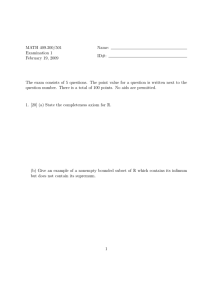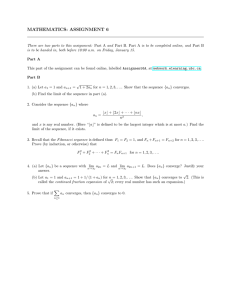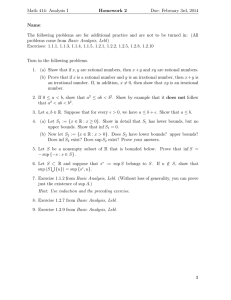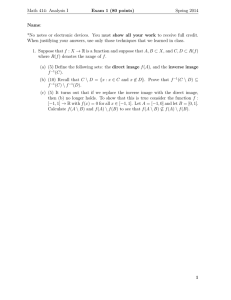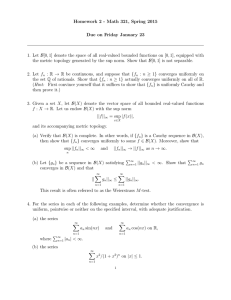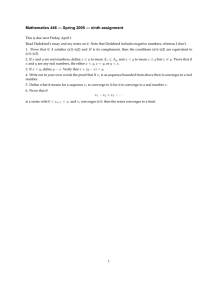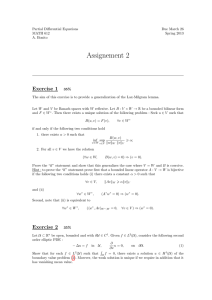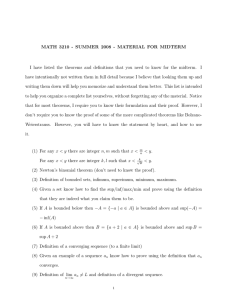Math 3210 § 2. Second Midterm Exam Name: Solutions
advertisement
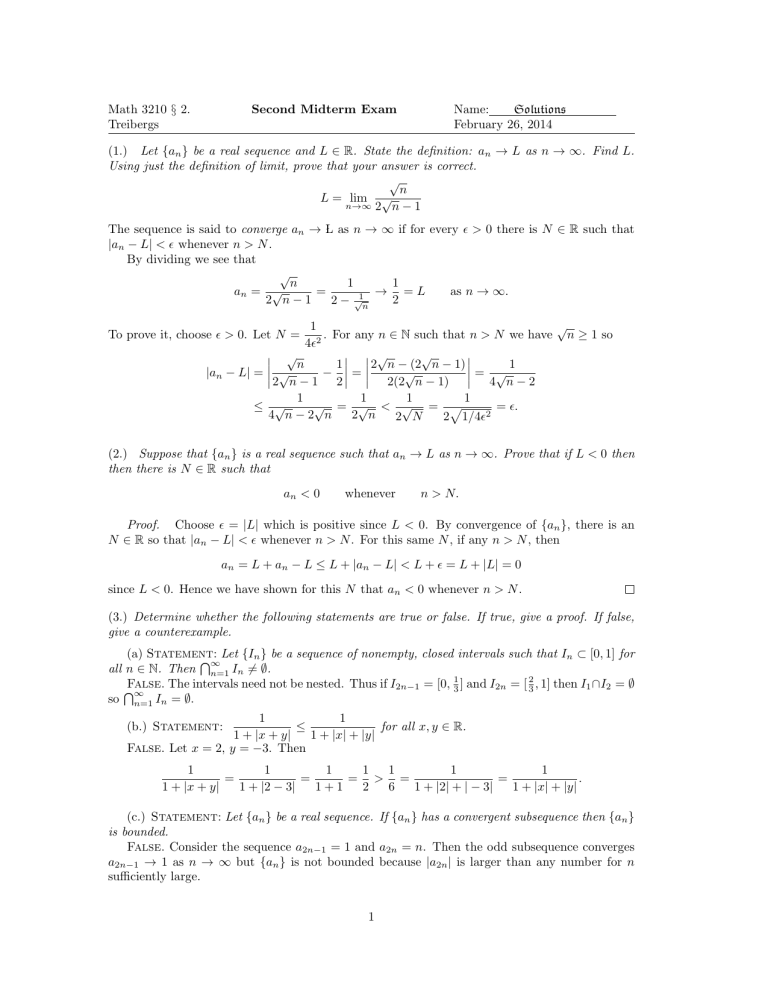
Math 3210 § 2.
Treibergs
Second Midterm Exam
Name:
Solutions
February 26, 2014
(1.) Let {an } be a real sequence and L ∈ R. State the definition: an → L as n → ∞. Find L.
Using just the definition of limit, prove that your answer is correct.
√
n
L = lim √
n→∞ 2 n − 1
The sequence is said to converge an → L as n → ∞ if for every > 0 there is N ∈ R such that
|an − L| < whenever n > N .
By dividing we see that
√
1
n
1
=
an = √
→ =L
as n → ∞.
2
2 n−1
2 − √1n
√
1
. For any n ∈ N such that n > N we have n ≥ 1 so
2
4
√
√
√
1
1
2 n − (2 n − 1)
n
√
= √
−
=
|an − L| = √
2 n−1 2
2(2 n − 1)
4 n−2
1
1
1
1
√ = √ < √ = p
≤ √
= .
4 n−2 n
2 n
2 N
2 1/42
To prove it, choose > 0. Let N =
(2.) Suppose that {an } is a real sequence such that an → L as n → ∞. Prove that if L < 0 then
then there is N ∈ R such that
an < 0
whenever
n > N.
Proof. Choose = |L| which is positive since L < 0. By convergence of {an }, there is an
N ∈ R so that |an − L| < whenever n > N . For this same N , if any n > N , then
an = L + an − L ≤ L + |an − L| < L + = L + |L| = 0
since L < 0. Hence we have shown for this N that an < 0 whenever n > N .
(3.) Determine whether the following statements are true or false. If true, give a proof. If false,
give a counterexample.
(a) Statement:
T∞ Let {In } be a sequence of nonempty, closed intervals such that In ⊂ [0, 1] for
all n ∈ N. Then n=1 In 6= ∅.
False. The intervals need not be nested. Thus if I2n−1 = [0, 31 ] and I2n = [ 32 , 1] then I1 ∩I2 = ∅
T
∞
so n=1 In = ∅.
1
1
≤
for all x, y ∈ R.
1 + |x + y|
1 + |x| + |y|
False. Let x = 2, y = −3. Then
(b.) Statement:
1
1
1
1
1
1
1
=
=
= > =
=
.
1 + |x + y|
1 + |2 − 3|
1+1
2
6
1 + |2| + | − 3|
1 + |x| + |y|
(c.) Statement: Let {an } be a real sequence. If {an } has a convergent subsequence then {an }
is bounded.
False. Consider the sequence a2n−1 = 1 and a2n = n. Then the odd subsequence converges
a2n−1 → 1 as n → ∞ but {an } is not bounded because |a2n | is larger than any number for n
sufficiently large.
1
(4.) For the given real sequence of numbers {an }, prove that this sequence converges.
an =
1
1
1
1
1
+ 5 + 7 + · · · + 2n−1
+
2 23
2
2
2
The sequence is monotonically non-decreasing. To see it, observe that for every n ∈ N
an+1 = an +
1
> an .
22(n+1)−1
The sequence is bounded above. Use the fact that for every k ∈ N we have 2k − 1 ≥ k − 1 so that
n
n k−1
X
1 − 12
1
1
1
1
1
1
1
=
an = +· · ·+ 2k−1 +· · ·+ 2n−1 ≤ 0 +· · ·+ k−1 +· · ·+ n−1 =
≤ 2.
2
2
2
2
2
2
2
1 − 12
k=1
It follows that the sequence converges by the monotone convergence theorem.
(5.) Let E ⊂ R, s ∈ R and f : E → R be a function. Define: s = sup f (x). Find s = sup f (x)
x∈E
x∈E
where f (x) = x2 and E = (0, 1). Prove your answer.
If f (x) is not bounded above we say the supremum sup f (x) = ∞. If f is bounded above then
x∈E
the supremum of the function, s = sup f (x), is a number s ∈ R that is (1) an upper bound: for
x∈E
every x ∈ E, f (x) ≤ s and (2) the least among upper bounds: for every smaller number b < s
there is x ∈ E so that b < f (x), in other words, no smaller number is an upper bound.
sup x2 = 1. To see it, observe that if 0 < y < 1 then we can take a number x = 1 − c for
x∈(0,1)
some small c > 0 so that x2 = 1 − 2c + c2 > 1 − 2c = b if c = (1 − b)/2. From this we may write
a proof.
Proof. To see that 1 is an upper bound, note that any x ∈ (0, 1) satisfies 0 < x < 1 so
(multiplying by x > 0) 0 < x2 < x < 1 so that for every x ∈ E we have f (x) ≤ 1. To see that
1 is the least of all upper bounds, suppose that b < 1 to show b cannot be an upper bound. If
b ≤ 0 then let x = 21 ∈ (0, 1). In this case we have b ≤ 0 < 41 = f (x) for this x ∈ E. On the other
hand, if 0 < b < 1 we have 0 < 12 (1 − b) < 1 so x = 1 − 12 (1 − b) ∈ (0, 1). It also satisfies
1
x2 = 1 − (1 − b) + (1 − b)2 > 1 − (1 − b) = b.
4
In both cases, for every b < 1 there is x ∈ E so that b < f (x), proving 1 is least among upper
bounds.
2
